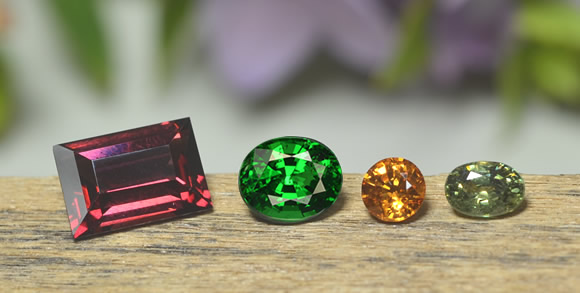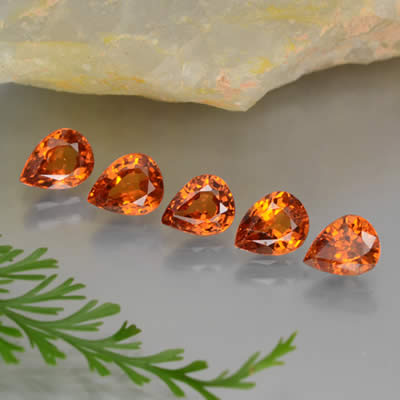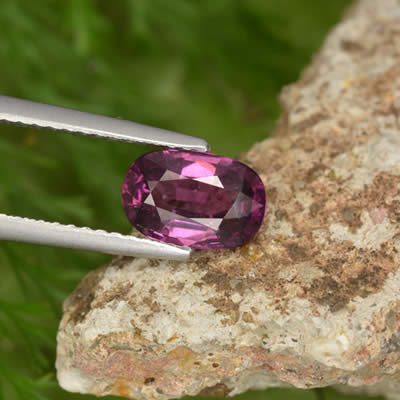Your Details
Your Details
|
Reviewed By Andreas Zabczyk
Rare Garnets: Tsavorite, Spessartite, and RhodoliteGarnet has long been admired for its durability - measuring 7 to 7.5 on the Mohs scale - and for its natural brilliance. Garnets reached the height of popularity during the 18th and 19th centuries, when Bohemian garnet jewelry dominated European fashion. Today, garnets remain a favorite among gem lovers thanks to their versatility and affordability. Discover a full range of loose garnet gemstones in many cuts, shapes, and colors to suit any style. For a full gemological overview, visit our Garnet Gemstone Information page. 
Rhodolite, Tsavorite, Spessartite & Demantoid Garnets
Garnet is often associated with affordable, dark-red stones, sometimes with a noticeable brownish hue. While this describes many common garnets, there are rare and breathtaking garnet varieties with vibrant and surprising colors that have reignited collector demand and market interest. If you’re interested in buying one of these, check out our Garnet Buying Guide for tips. Spessartite garnet, for example, is a vivid orange-to-reddish gemstone colored by manganese and, in deeper reds, by iron. This beautiful garnet is mined in Nigeria, Mozambique, and Namibia, and has enjoyed good production in recent years, although experts believe this could change. Many grades of spessartite are on the market, with moderately included gems available at reasonable prices. However, very clean, rich mandarin-orange spessartite is extremely valuable, especially in larger sizes. 
Pear-Shaped Spessartite Garnet Gems
Tsavorite garnet is another exceptional member of the garnet group, belonging to the grossular family. Discovered in the 1960s along the Kenya-Tanzania border, tsavorite displays an intense medium to deep green color, sometimes rivaling emeralds in beauty. While moderate inclusions are common, the finest tsavorites are bright, clean, and extremely valuable. Stones over two carats are especially rare and prized. Tsavorite colors range from a lively light green to a rich bluish-green, making them a popular alternative to emerald for their durability and sparkle. This gem was widely promoted by jewelers in the 1970s, leading to greater demand and recognition around the world. Tsavorite was once mined from dozens of localities, but today commercial production is limited to only a handful of mining operations in Kenya and Tanzania, contributing to its rarity and high price. Rhodolite garnet is a striking pink-to-violet-red stone whose name comes from the Greek “rhodon,” meaning rose-colored. George Frederick Kunz, a noted gemologist, named rhodolite after the mountain rhododendron flowers of North Carolina, which share its lovely hue. Rhodolite sits chemically between almandine and pyrope garnet, but its distinct rose color sets it apart. The finest pink rhodolite garnets come from Sri Lanka, Tanzania, and Zimbabwe. Large gems over 10 carats are very rare, but occasionally large stones are cut from top-quality Tanzanian rough. You can learn more about garnet powers and symbolism on our Garnet Meaning and Powers page. 
Rhodolite Garnet Gemstone
Beyond spessartite, tsavorite, and rhodolite, a few other rare garnets deserve mention. Demantoid garnet, a spectacular green gemstone, is famous for its exceptional dispersion and brilliance. Its color is usually a vibrant green with a subtle yellow-brown undertone, making it distinct from tsavorite. Demantoid was first found in Russia’s Ural Mountains and is now also mined in Namibia, though production remains scarce and highly valued among collectors. Another fascinating member is color-change garnet, a blend of spessartite and pyrope that shows dramatic shifts from blue to violet depending on light conditions. Its color transformation is often more striking than even the celebrated alexandrite. These gems are incredibly rare and quickly snapped up whenever they appear on the market. For a broader introduction to garnets, see All About Garnet. |
